Influence of Quantity and Quality of Bonding Phases on Strength of Iron Ore Sinters
Abstract
1. Introduction
2. Materials and Methods
2.1. Materials
2.2. Methods
2.2.1. Strength of the Sinter
2.2.2. Fluidity Characteristic
2.2.3. Melt Absorbability
2.2.4. Strength of the Bonding Phase
3. Results
4. Discussion
4.1. Influence of Fluidity of Effective Melt on the Strength of the Sinter
4.2. Influence of Strength of the Bonding Phase on the Strength of the Sinter
4.3. Multivariable Linear Regression Analysis
0.90 ≤ FMI ≤ 3.00, 0.06 ≤ MAI ≤ 0.13, 80 ≤ CS ≤ 206
5. Conclusions
Author Contributions
Funding
Data Availability Statement
Acknowledgments
Conflicts of Interest
References
- Mohammad, S.; Patra, S.; Harichandan, B. Reductants in Iron Ore Sintering: A Critical Review. Fuel 2023, 332, 126194. [Google Scholar] [CrossRef]
- Lu, L.; Ishiyama, O.; Higuchi, T.; Matsumura, M.; Higuchi, K. Iron Ore Sintering. In Iron Ore, 2nd ed.; Lu, L., Ed.; Woodhead Publishing Series in Metals and Surface Engineering; Woodhead Publishing: Cambridge, UK, 2022; Chapter 15; pp. 489–538. ISBN 978-0-12-820226-5. [Google Scholar]
- Fernández-González, D.; Ruiz-Bustinza, I.; Mochón, J.; González-Gasca, C.; Verdeja, L.F. Iron Ore Sintering: Process. Miner. Process. Extr. Met. Rev. 2017, 38, 215–227. [Google Scholar] [CrossRef]
- Park, J.; Kim, E.; Suh, I.-K.; Lee, J. A Short Review of the Effect of Iron Ore Selection on Mineral Phases of Iron Ore Sinter. Minerals 2022, 12, 35. [Google Scholar] [CrossRef]
- Liu, D.; Loo, C.E. Importance of Melt Generation and Properties in Iron Ore Sintering. ISIJ Int. 2016, 56, 527–536. [Google Scholar] [CrossRef]
- Umadevi, T.; Brahmacharyulu, A.; Roy, A.K.; Mahapatra, P.C.; Prabhu, M.; Ranjan, M. Influence of Iron Ore Fines Feed Size on Microstructure, Productivity and Quality of Iron Ore Sinter. ISIJ Int. 2011, 51, 922–929. [Google Scholar] [CrossRef]
- Yang, S.; Yu, C.; He, S.; Zhao, Y.; Yang, S.; Liu, H. Influence of chemical composition in iron ore powder on basic characteristics of sintering at high temperature. China Met. 2023, 33, 47–54. [Google Scholar] [CrossRef]
- Li, Y.; Wang, B.; Zhou, Z.; Yang, A.; Bai, Y. Research Progress of Intelligent Ore Blending Model. Metals 2023, 13, 379. [Google Scholar] [CrossRef]
- Chen, L.; Gu, Q.; Wang, R.; Feng, Z.; Zhang, C. Comprehensive Utilization of Mineral Resources: Optimal Blending of Polymetallic Ore Using an Improved NSGA-III Algorithm. Sustainability 2022, 14, 10766. [Google Scholar] [CrossRef]
- Yang, S.; Liu, H.; Sun, H.; Zhang, T.; Liu, S. Study on Influencing Factors of High-Temperature Basic Characteristics of Iron Ore Powder and Optimization of Ore Blending. Materials 2022, 15, 3329. [Google Scholar] [CrossRef]
- Huang, X.; Fan, X.; Chen, X.; Gan, M.; Ji, Z.; Zheng, R. A Novel Blending Principle and Optimization Model for Low-Carbon and Low-Cost Sintering in Ironmaking Process. Powder Technol. 2019, 355, 629–636. [Google Scholar] [CrossRef]
- Tang, J.; Wang, M.; Chu, M.; Shi, Q.; Zhang, Z. Process of ore blending optimization in sintering at home and abroad. Iron Steel 2024, 59, 102–113. [Google Scholar] [CrossRef]
- Bao, G.; Liu, L.; Han, X.; Duan, B.; Qin, L. Optimization of sintering raw material blending scheme based on RDI>3.15 mm response surface methodology. Iron Steel 2023, 58, 31–38. [Google Scholar] [CrossRef]
- Bao, G.; Liu, L.; Han, X.; Duan, B.; Qin, L.; Liu, Y. Optimization of sintering ore blending by response surface-satisfaction function method. Iron Steel 2023, 58, 41–50. [Google Scholar] [CrossRef]
- Hou, J.; Bai, C.; Hu, M.; Liu, X.; Huang, X.; Guo, L. Optimization on ore-blending of PMC concentrate and two typical limonite ores. Iron Steel 2023, 58, 45–52+60. [Google Scholar] [CrossRef]
- Donskoi, E.; Manuel, J.R.; Clout, J.M.F.; Zhang, Y. Mathematical Modeling and Optimization of Iron Ore Sinter Properties. Isr. J. Chem. 2007, 47, 373–379. [Google Scholar] [CrossRef]
- Li, H.; Pinson, D.J.; Zulli, P.; Lu, L.; Longbottom, R.J.; Chew, S.J.; Monaghan, B.J.; Zhang, G. Interaction between Mineral Phases in a Hematite Iron Ore and Fluxing Materials during Sintering. Met. Mater. Trans. B 2021, 52, 267–281. [Google Scholar] [CrossRef]
- Li, H.; Pinson, D.J.; Zulli, P.; Lu, L.; Longbottom, R.J.; Chew, S.J.; Monaghan, B.J.; Zhang, G. Interaction between Mineral Phases in a Goethitic Iron Ore and Fluxing Materials during Sintering. Met. Mater. Trans. B 2021, 52, 996–1011. [Google Scholar] [CrossRef]
- Umadevi, T.; Bandopadhyay, U.K.; Mahapatra, P.C.; Prabhu, M.; Ranjan, M. Influence of Limestone Particle Size on Iron Ore Sinter Properties and Productivity. Steel Res. Int. 2010, 81, 419–425. [Google Scholar] [CrossRef]
- Niu, L.; Zhang, J.; Wang, Y.; Kang, J.; Li, S.; Shan, C.; Li, Z.; Liu, Z. Iron Ore Granulation for Sinter Production: Developments, Progress, and Challenges. ISIJ Int. 2023, 63, 601–612. [Google Scholar] [CrossRef]
- You, Y.; Guo, J.; Zheng, Z.; Li, G.; Li, Y.; Lv, X.; Yang, R. Comparisons of Iron Ore Granulation and Sintering Performance between Horizontal High-Shear Granulators and Drum Granulators. Powder Technol. 2022, 402, 117367. [Google Scholar] [CrossRef]
- Wu, S.; Que, Z.; Li, K. Strengthening Granulation Behavior of Specularite Concentrates Based on Matching of Characteristics of Iron Ores in Sintering Process. J. Iron. Steel Res. Int. 2018, 25, 1017–1025. [Google Scholar] [CrossRef]
- Umadevi, T.; Deodhar, A.V.; Mahapatra, P.C.; Prabhu, M.; Ranjan, M. Influence of Coating Granulation Process on Iron Ore Sinter Quality and Productivity. Steel Res. Int. 2010, 81, 716–723. [Google Scholar] [CrossRef]
- Cores, A.; Babich, A.; Muñiz, M.; Ferreira, S.; Mochon, J. The Influence of Different Iron Ores Mixtures Composition on the Quality of Sinter. ISIJ Int. 2010, 50, 1089–1098. [Google Scholar] [CrossRef]
- Otomo, T.; Takasaki, Y.; Kawaguchi, T. Properties of Core Ore in Quasi-Particle Required for Large Amounts Usage of Limonitic Ores in Iron Ore Sintering Process. ISIJ Int. 2005, 45, 532–537. [Google Scholar] [CrossRef]
- Okazaki, J.; Higuchi, K.; Hosotani, Y.; Shinagawa, K. Influence of Iron Ore Characteristics on Penetrating Behavior of Melt into Ore Layer. ISIJ Int. 2003, 43, 1384–1392. [Google Scholar] [CrossRef]
- Wu, S.-L.; Su, B.; Qi, Y.-H.; Kou, M.-Y.; Li, Y.; Zhang, W.-L. Melt Absorbability of Iron Ore Nuclei and Its Influence on Suitable Liquid Content of Sintered Body. Met. Mater. Trans. B 2017, 48, 2469–2480. [Google Scholar] [CrossRef]
- Li, B.; Zhou, H.; Huang, J.; Zhang, Z.; She, X.; Wang, J.; Wu, S.; Kou, M. Optimization of Iron Ore Blending Based on Replacing Australian Low Alumina Limonite. J. Iron Steel Res. Int. 2023, 30, 1675–1686. [Google Scholar] [CrossRef]
- Liang, Z.; Chen, J.; Huang, Z.; Huang, B. Characteristics and Sintering Mechanisms of Iron Ores with a High Proportion of High-Al2O3 Limonite. ACS Omega 2023, 8, 15951–15959. [Google Scholar] [CrossRef]
- He, H.; Lv, X.; Wang, J. Characteristics Evaluation and High Effective Utilization of Limonite Ores in Sintering Process. Min. Met. Explor. 2021, 38, 2271–2283. [Google Scholar] [CrossRef]
- Wu, S.; Zhang, G. Liquid Absorbability of Iron Ores and Large Limonite Particle Divided Adding Technology in the Sintering Process. Steel Res. Int. 2015, 86, 1014–1021. [Google Scholar] [CrossRef]
- Liu, D.; Liu, H.; Zhang, J.; Liu, Z.; Xue, X.; Wang, G.; Kang, Q. Basic Characteristics of Australian Iron Ore Concentrate and Its Effects on Sinter Properties during the High-Limonite Sintering Process. Int. J. Miner. Met. Mater. 2017, 24, 991–998. [Google Scholar] [CrossRef]
- Zhang, G.; Luo, G.; Chai, Y.; Song, W. Effect of limonite on morphology and micro-area composition of sinter calcium ferrite. Iron Steel 2024, 59, 22–32. [Google Scholar] [CrossRef]
- Chen, T.; Wan, J.; Hu, M.; Zhou, X.; Luo, Y.; Liu, J. Mineralization Behavior and Strengthening Mechanism of Limonitic Laterite Ore Sintering Process Enhanced by Calcined Lime Coating. JOM 2024, 76, 875–884. [Google Scholar] [CrossRef]
- Zhang, G.; Luo, G.; Chai, Y.; Tian, S.; Hao, S.; Ren, Q. Optimal allocation of limonite in sintering process. Chin. J. Eng. 2022, 44, 39–49. [Google Scholar] [CrossRef]
- Liu, D.; Zhang, J.; Liu, Z.; Li, K.; Wang, Y.; Wang, G. Effects of Liquid Infiltration Characteristics of Iron Ores with a High Proportion of Limonite on Sinter Strength. Met. Res. Technol. 2016, 113, 301. [Google Scholar] [CrossRef]
- Zhao, Q.; Xue, J. Sintering Test Research of High Proportion Limonite. In Proceedings of the 10th International Symposium on High-Temperature Metallurgical Processing; Jiang, T., Hwang, J.-Y., Gregurek, D., Peng, Z., Downey, J.P., Zhao, B., Yücel, O., Keskinkilic, E., Padilla, R., Eds.; Springer International Publishing: Cham, Switzerland, 2019; pp. 189–198. [Google Scholar]
- Chen, S.; Zhang, X.; Liang, J.; Wang, D.; Pan, W.; Zhang, Y. Experimental analysis on ultra-deep bed sintering in Shougang Jingtang. China Met. 2023, 33, 94–102. [Google Scholar] [CrossRef]
- Hayashi, N.; Komarov, S.V.; Kasai, E. Heat Transfer Analysis of the Mosaic Embedding Iron Ore Sintering (MEBIOS) Process. ISIJ Int. 2009, 49, 681–686. [Google Scholar] [CrossRef]
- Matsumura, M.; Yamaguchi, Y.; Hara, M.; Kamijo, C.; Kawaguchi, T.; Nakagawa, Y. Improvement of Sinter Productivity by Adding Return Fine on Raw Materials after Granulation Stage. ISIJ Int. 2013, 53, 34–40. [Google Scholar] [CrossRef]
- Zhang, G.; Wu, S.; Su, B.; Que, Z.; Hou, C.; Jiang, Y. Influencing Factor of Sinter Body Strength and Its Effects on Iron Ore Sintering Indexes. Int. J. Miner. Met. Mater. 2015, 22, 553–561. [Google Scholar] [CrossRef]
- Cheng, Z.; Yang, J.; Zhou, L.; Liu, Y.; Wang, Q. Sinter Strength Evaluation Using Process Parameters under Different Conditions in Iron Ore Sintering Process. Appl. Therm. Eng. 2016, 105, 894–904. [Google Scholar] [CrossRef]
- Zhang, B.; Zhou, J.; Li, M. Prediction of Sinter Yield and Strength in Iron Ore Sintering Process by Numerical Simulation. Appl. Therm. Eng. 2018, 131, 70–79. [Google Scholar] [CrossRef]
- Li, H.; Zhang, J.; Pei, Y.; Zhao, Z.; Ma, Z. Melting Characteristics of Iron Ore Fine during Sintering Process. J. Iron Steel Res. Int. 2011, 18, 11–15. [Google Scholar] [CrossRef]
- Webster, N.A.S.; Pownceby, M.I. Exploring the Relationship Between Fe-Rich SFCA and SFCA-III and Their Presence in Sinter Strand and Pot-Grate Sinter. ISIJ Int. 2024, 64, 803–807. [Google Scholar] [CrossRef]
- Chen, X.; Wang, W.; Yang, D.; Zheng, H.; Wang, B. Mineralization Characteristics of Iron Ore Sinter and the Effects of Cooling Rate on Mineral Phase Structure. ISIJ Int. 2023, 63, 261–270. [Google Scholar] [CrossRef]
- Wu, Y.; Gao, L. Effect of high-silicon iron ore on sintered on ore sintering process and metallurgical properties. Iron Steel 2024, 59, 25–35. [Google Scholar] [CrossRef]
- Ding, C.; Yang, T.; Long, H.; Han, F.; Qiu, J.; Luo, Y. Effect of w(MgO)/w(Al2O3) on sintered ore mineralization characteristics and metallurgical properties. Iron Steel 2023, 58, 25–33. [Google Scholar] [CrossRef]
- Shen, F.; An, H.; Jiang, X.; Ni, J.; Zheng, H.; Gao, Q. Research progress on sillico-ferrite of calcium and aluminum (SFCA) bonding phase in sintering process. Iron Steel 2024, 59, 1–12. [Google Scholar] [CrossRef]
- Nguyen, T.B.T.; Singh, T.; O’Dea, D.; Matthews, L.; Honeyands, T. Experimental Analysis of the Melt Fraction—Mechanical Strength Relationship for Iron Ore Sinter Analogues. Powder Technol. 2024, 439, 119698. [Google Scholar] [CrossRef]
- Hapugoda, S.; Lu, L.; Donskoi, E.; Manuel, J. Mineralogical Quantification of Iron Ore Sinter. Miner. Process. Extr. Met. 2016, 125, 156–164. [Google Scholar] [CrossRef]
- Clout, J.M.F.; Manuel, J.R. Mineralogical, Chemical, and Physical Metallurgical Characteristics of Iron Ore. In Iron Ore, 2nd ed.; Lu, L., Ed.; Woodhead Publishing Series in Metals and Surface Engineering; Woodhead Publishing: Cambridge, UK, 2022; Chapter 2; pp. 59–108. ISBN 978-0-12-820226-5. [Google Scholar]
- Honeyands, T.; Manuel, J.; Matthews, L.; O’Dea, D.; Pinson, D.; Leedham, J.; Zhang, G.; Li, H.; Monaghan, B.; Liu, X.; et al. Comparison of the Mineralogy of Iron Ore Sinters Using a Range of Techniques. Minerals 2019, 9, 333. [Google Scholar] [CrossRef]
- Wu, S.; Que, Z.; Zhai, X.; Li, K. Effect of Characteristics of Fine Iron Ores on the Granulation Behavior of Concentrate in Sintering Granulation Process. Met. Res. Technol. 2018, 115, 202. [Google Scholar] [CrossRef]
- Que, Z.; Wu, S.; Zhai, X.; Li, K. Effect of Characteristics of Coarse Iron Ores on the Granulation Behaviour of Concentrates in the Sintering Process. Ironmak. Steelmak. 2019, 46, 246–252. [Google Scholar] [CrossRef]
- Yuan, L.; Fan, X.; Can, M.; Yang, G.; Wang, Y. Structure Model of Granules for Sintering Mixtures. J. Iron Steel Res. Int. 2014, 21, 905–909. [Google Scholar] [CrossRef]
- Wu, S.; Zhang, G.; Chen, S.; Su, B. Influencing Factors and Effects of Assimilation Characteristic of Iron Ores in Sintering Process. ISIJ Int. 2014, 54, 582–588. [Google Scholar] [CrossRef]
- Que, Z.; Ai, X.; Wu, S. Reduction of NOx Emission Based on Optimized Proportions of Mill Scale and Coke Breeze in Sintering Process. Int. J. Miner. Met. Mater. 2021, 28, 1453–1461. [Google Scholar] [CrossRef]
- Oliveira, D.; Wu, S.; Dai, Y.; Xu, J.; Chen, H. Sintering Properties and Optimal Blending Schemes of Iron Ores. J. Iron Steel Res. Int. 2012, 19, 1–5. [Google Scholar] [CrossRef]
- Que, Z.; Ai, X. Effects of Iron Ores on the Combustion Behavior of Coke and NOx Emission during Sintering Process. ISIJ Int. 2021, 61, 1412–1422. [Google Scholar] [CrossRef]
- Honeyands, T.; Nguyen, T.B.T.; Pinson, D.; Connolly, P.R.J.; Pownceby, M.I.; Manuel, J.; Matthews, L.; Leedham, J.; Singh, T.; O’Dea, D.P. Variation in Iron Ore Sinter Mineralogy with Changes in Basicity. Minerals 2022, 12, 1249. [Google Scholar] [CrossRef]
- Webster, N.A.S.; Pownceby, M.I.; Madsen, I.C.; Studer, A.J.; Manuel, J.R.; Kimpton, J.A. Fundamentals of Silico-Ferrite of Calcium and Aluminum (SFCA) and SFCA-I Iron Ore Sinter Bonding Phase Formation: Effects of CaO:SiO2 Ratio. Met. Mater. Trans. B 2014, 45, 2097–2105. [Google Scholar] [CrossRef]
- Zhu, J.; Wu, S.; Fan, J.; Zhang, G.; Que, Z. Effect of the Separation of Large Limonite Ore Particles in the Granulation Process of Sinter Raw Materials. ISIJ Int. 2013, 53, 1529–1537. [Google Scholar] [CrossRef][Green Version]
- Harvey, T.; Pownceby, M.I.; Chen, J.; Webster, N.A.S.; Nguyen, T.B.T.; Matthews, L.; O’Dea, D.; Honeyands, T. Effect of Temperature, Time, and Cooling Rate on the Mineralogy, Morphology, and Reducibility of Iron Ore Sinter Analogues. JOM 2021, 73, 345–355. [Google Scholar] [CrossRef]
- Pownceby, M.I.; Webster, N.A.S.; Manuel, J.R.; Ware, N. The Influence of Ore Composition on Sinter Phase Mineralogy and Strength. Miner. Process. Extr. Met. 2016, 125, 140–148. [Google Scholar] [CrossRef]
- Han, H.; Shen, F.; Jiang, X.; Bi, C.; Zheng, H.; Gao, Q. Fundamental Mechanism of Effects of MgO on Sinter Strength. J. Iron Steel Res. Int. 2019, 26, 1171–1177. [Google Scholar] [CrossRef]
- Xin, R.; Guo, X. Effect of SiO2 on Crystallization of Calcium Ferrites in Fe2O3–CaO–SiO2–Al2O3 System in Cooling Process. Met. Mater. Trans. B 2022, 53, 1904–1919. [Google Scholar] [CrossRef]
- Ding, X.; Guo, X. The Sintering Characteristics of Mixing SiO2 with Calcium Ferrite at 1473 K (1200 °C). Met. Mater. Trans. B 2015, 46, 1742–1750. [Google Scholar] [CrossRef]
- Yang, D.; Wang, W.; Li, J.; Xu, R.; Wang, X.; Wang, G. Effect and Mechanism of Alumina on the Morphology and Mechanical Properties of Calcium Ferrite. Met. Mater. Trans. B 2020, 51, 776–785. [Google Scholar] [CrossRef]
- Pallant, J. SPSS Survival Manual: A Step by Step Guide to Data Analysis Using IBM SPSS, 7th ed.; Routledge: London, UK, 2020; ISBN 978-1-003-11745-2. [Google Scholar]
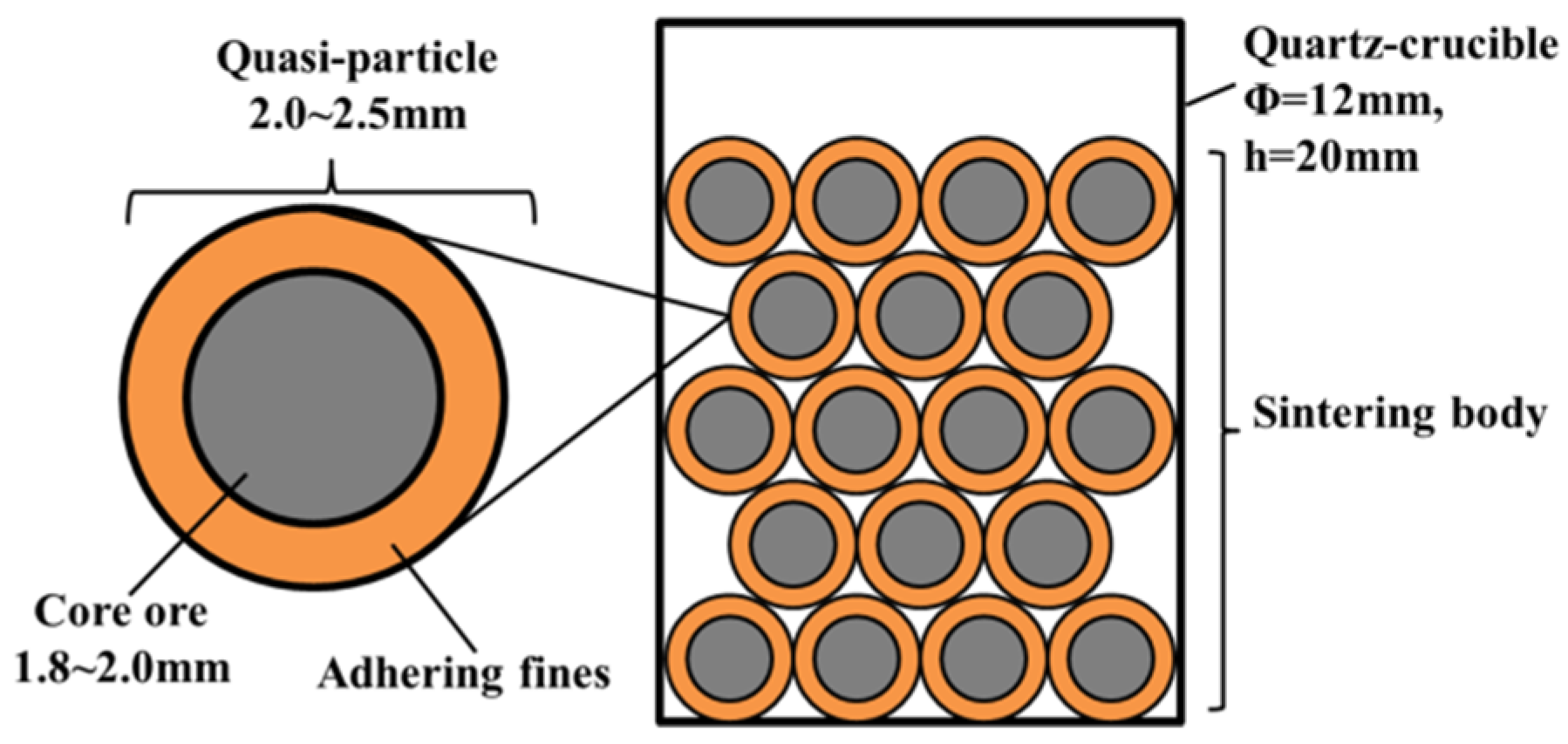
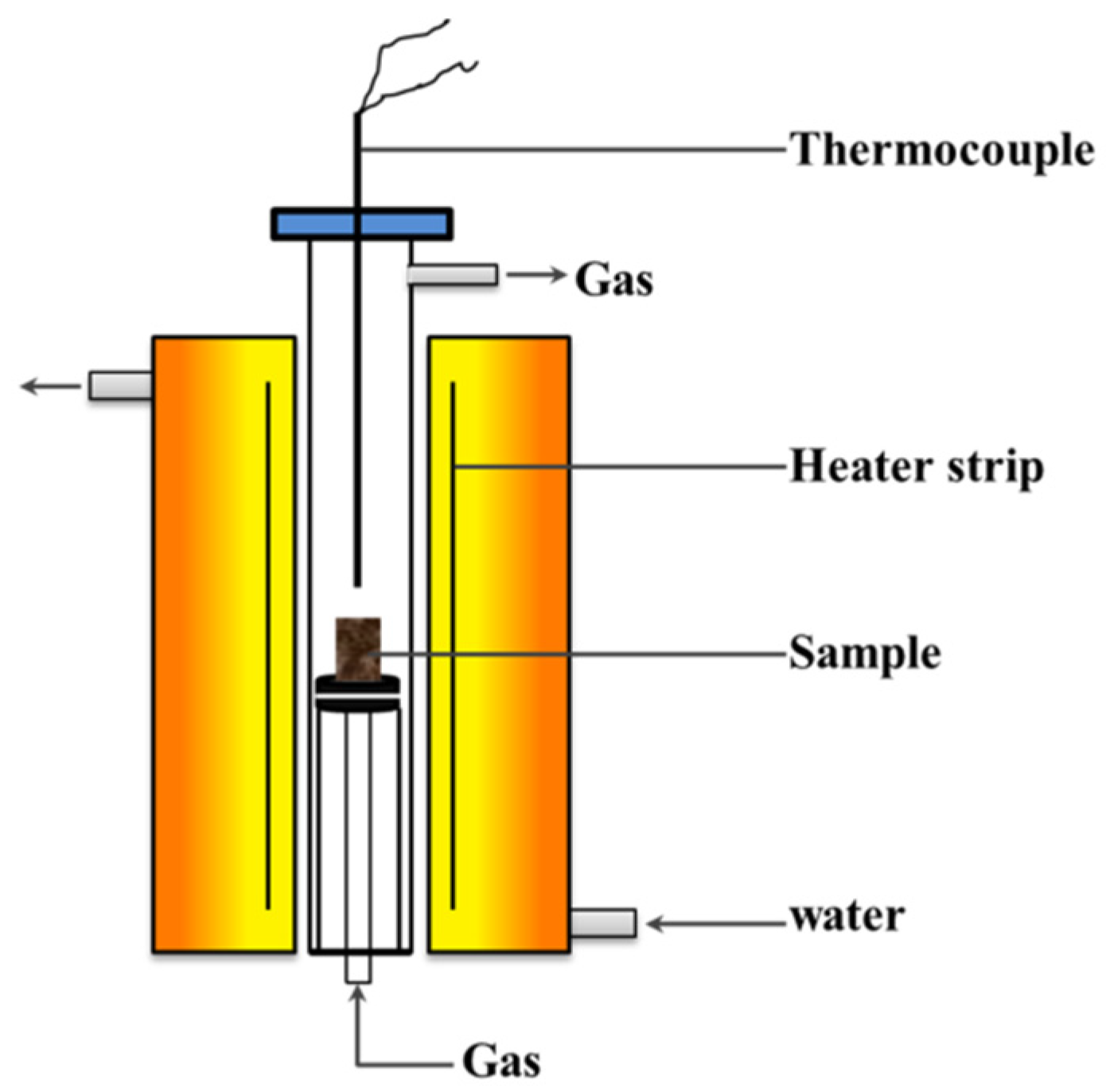

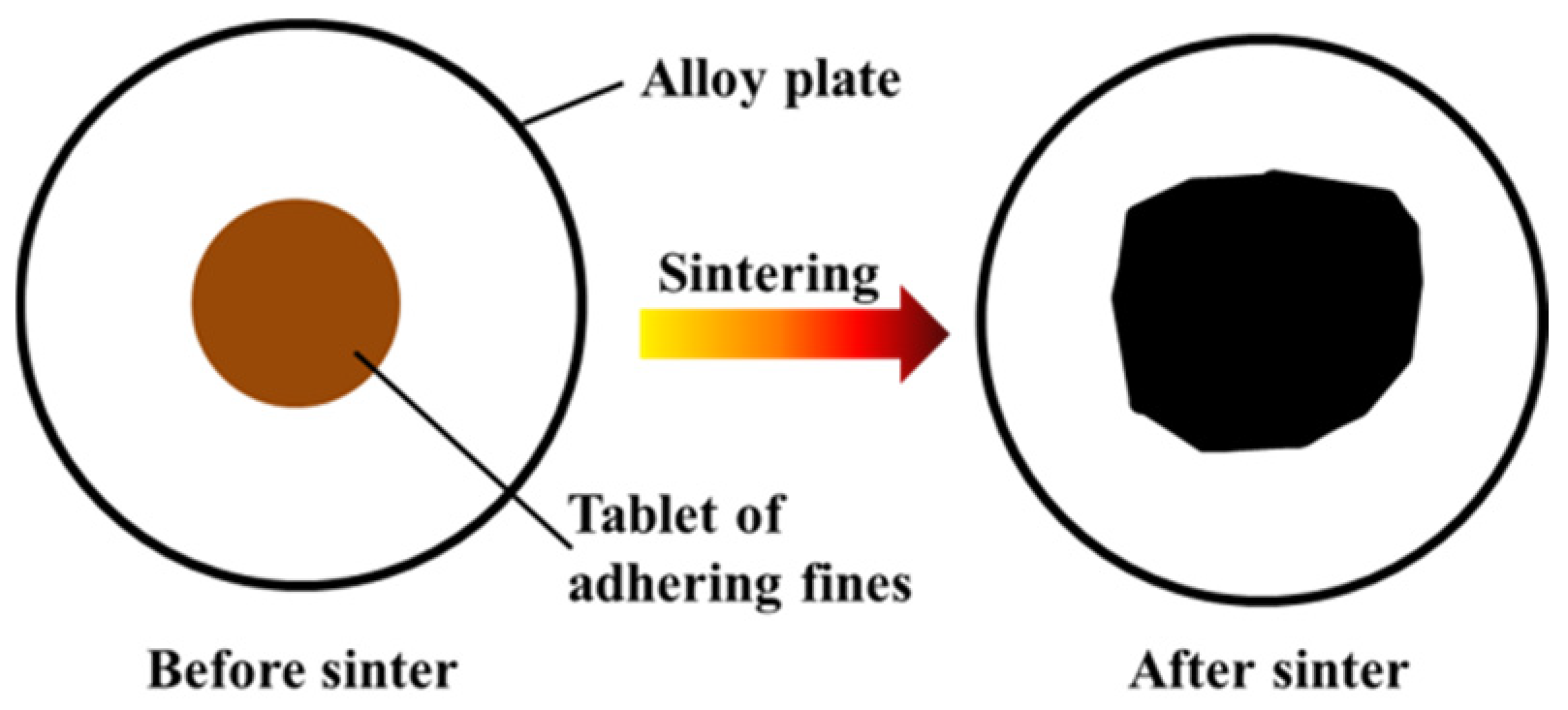

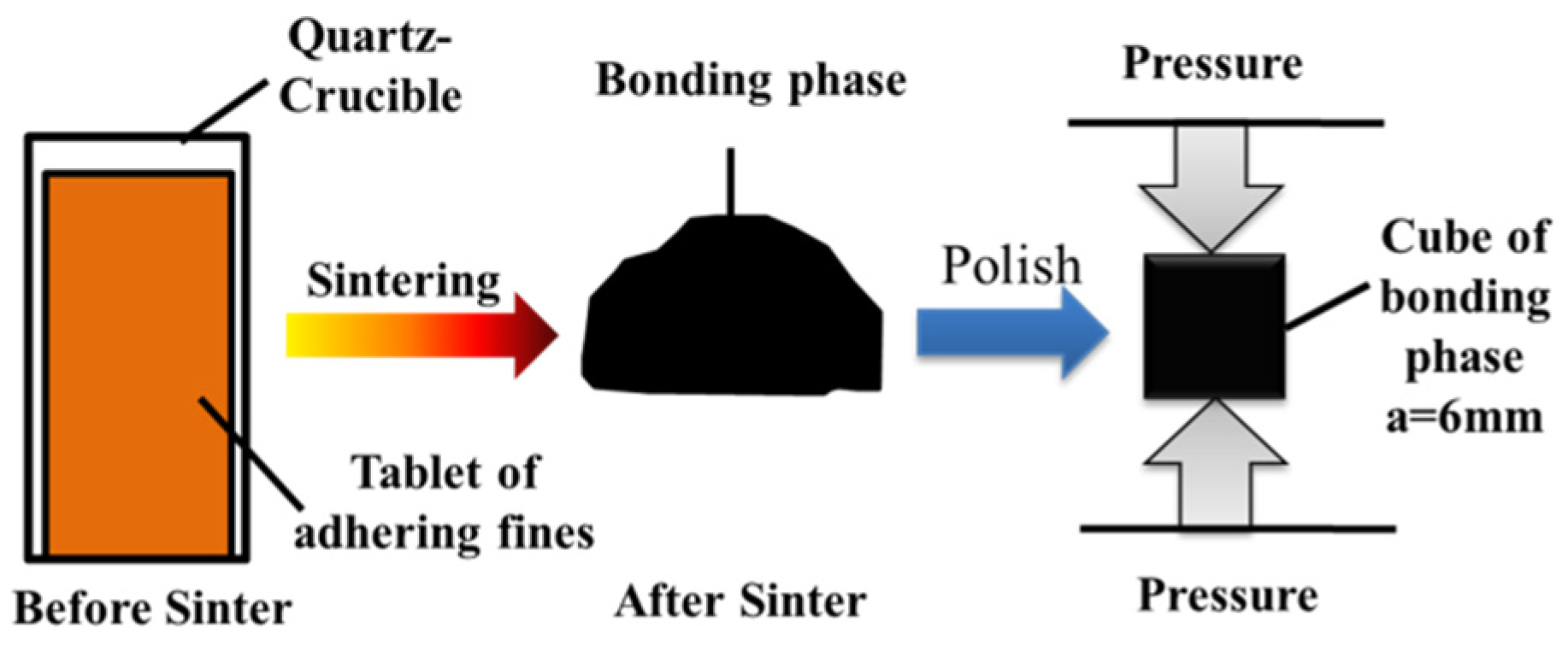
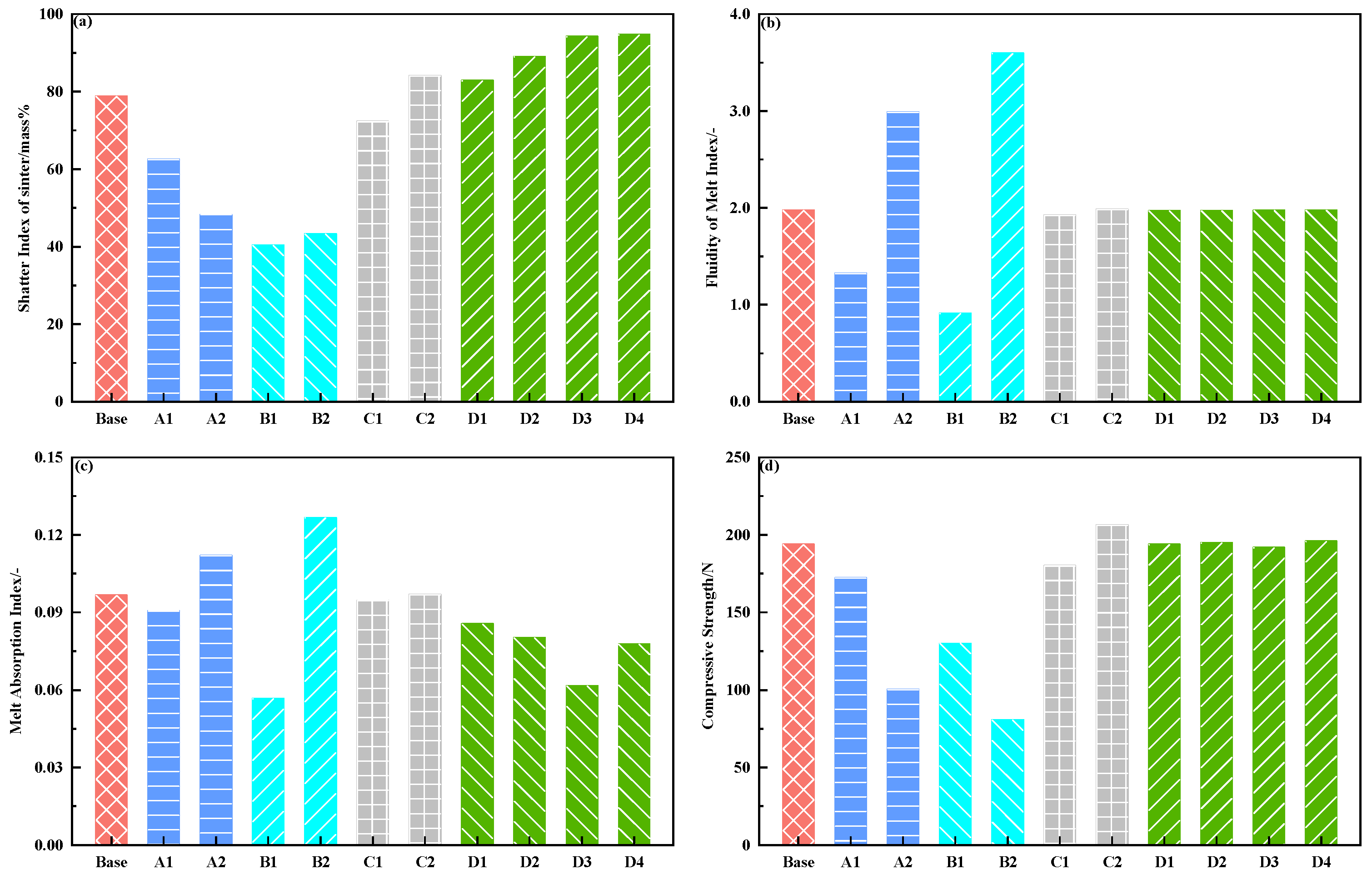
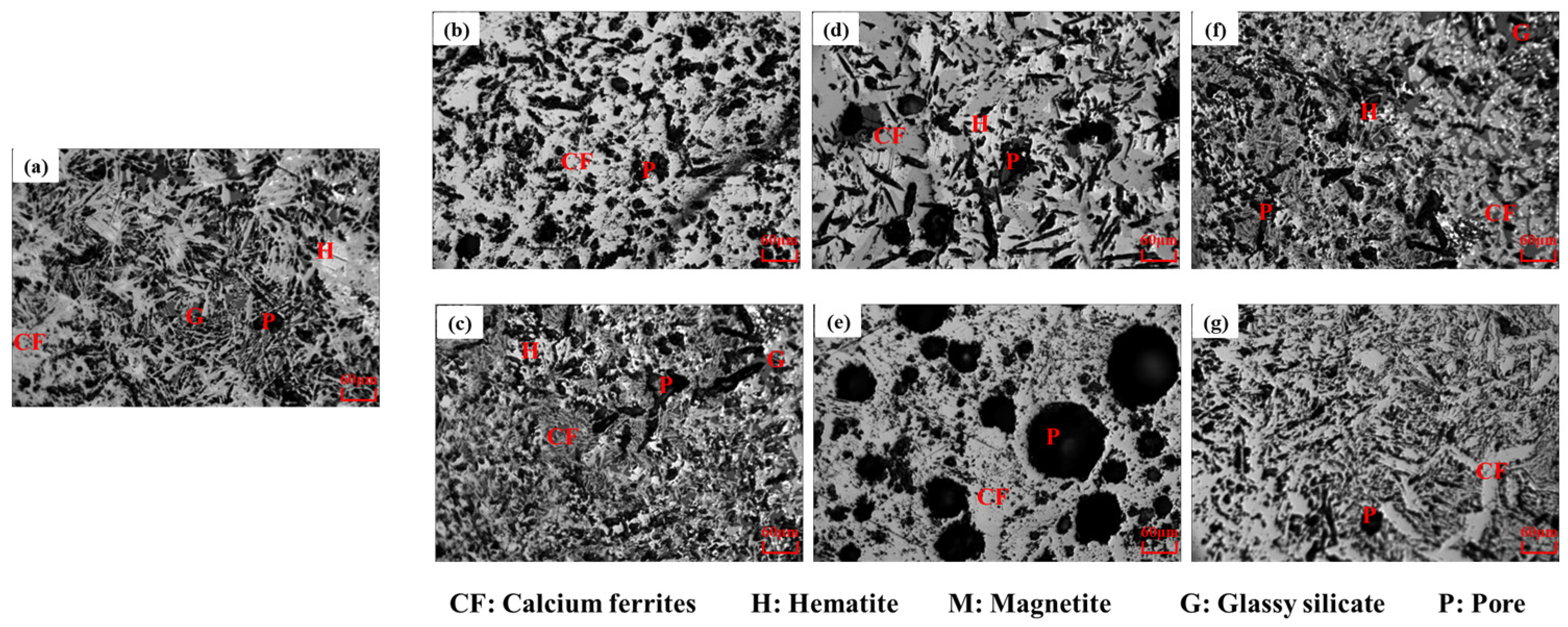

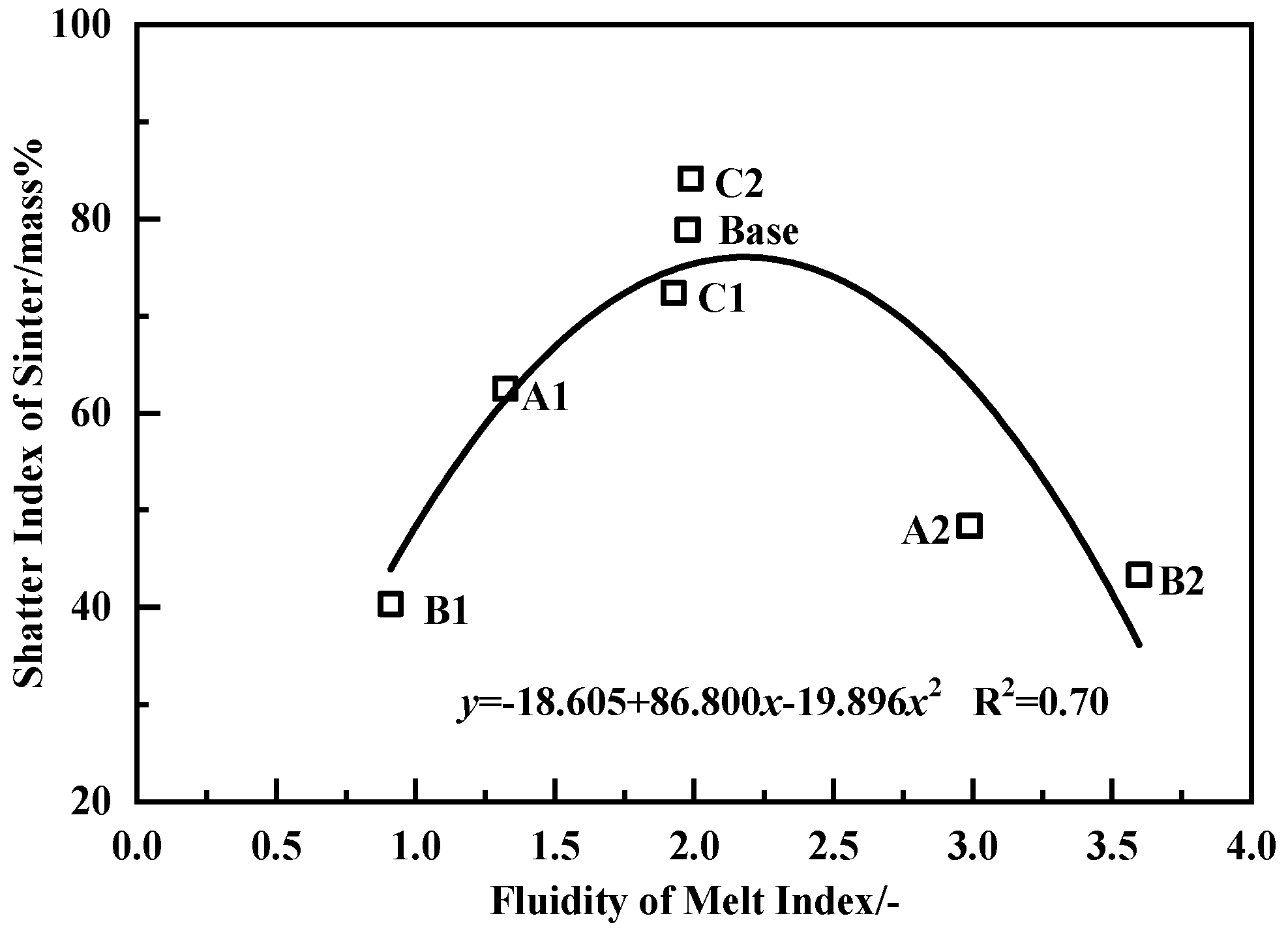
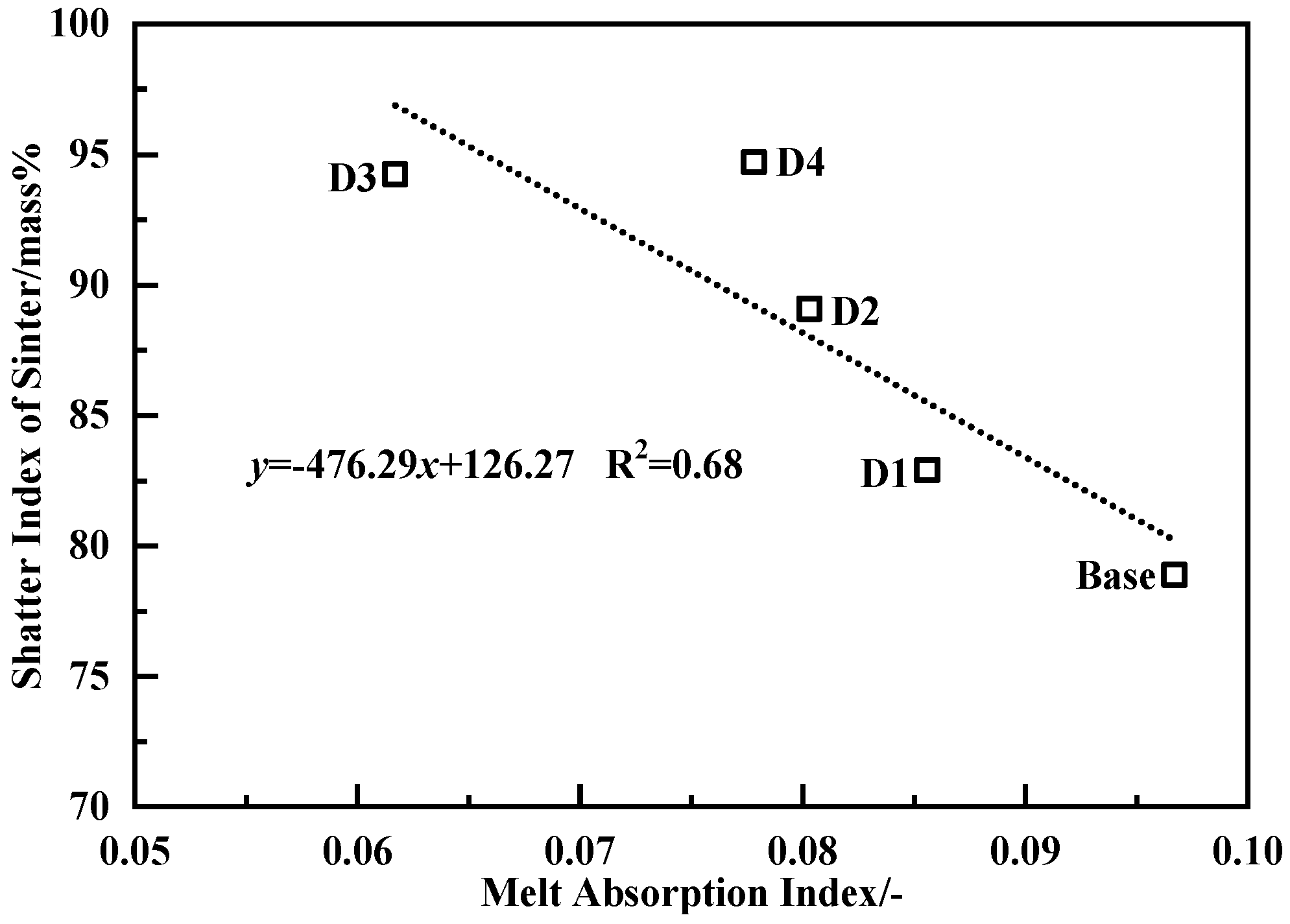

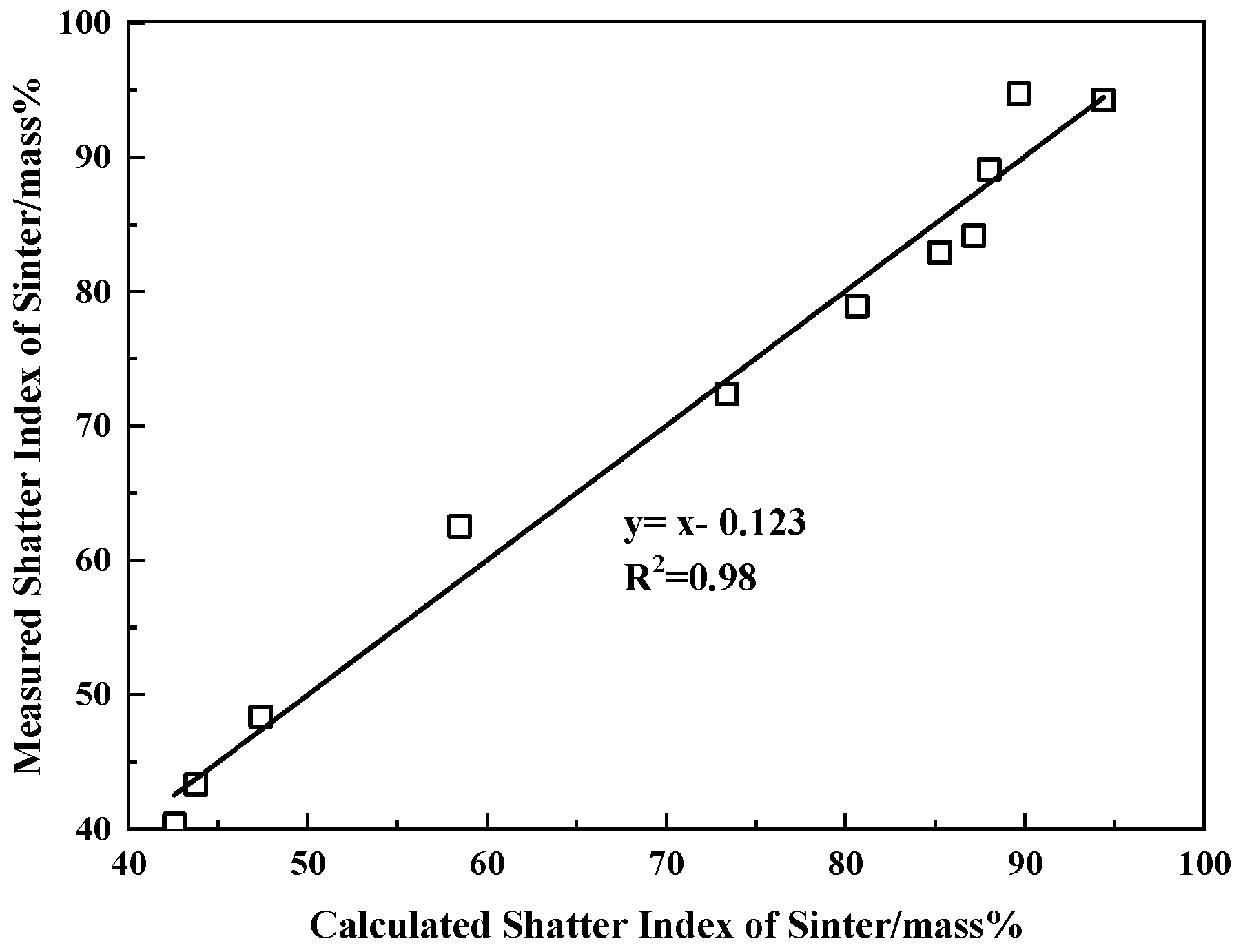
| Name | T. Fe | FeO | SiO2 | CaO | Al2O3 | MgO | MnO | P2O5 | Loss on Ignition |
|---|---|---|---|---|---|---|---|---|---|
| Ore-A | 57.99 | 0.19 | 5.40 | 0.04 | 1.61 | 0.05 | 0.05 | 0.10 | 10.17 |
| Ore-B | 61.07 | 0.30 | 3.70 | 0.03 | 2.20 | 0.05 | 0.12 | 0.14 | 6.24 |
| Ore-C | 62.46 | 0.28 | 4.41 | 0.03 | 2.35 | 0.04 | 0.10 | 0.17 | 3.29 |
| Ore-D | 64.89 | 0.55 | 4.55 | 0.02 | 0.73 | 0.07 | 0.27 | 0.09 | 1.36 |
| Ore-E | 65.36 | 0.17 | 1.78 | 0.02 | 1.31 | 0.03 | 1.17 | 0.06 | 2.09 |
| Ore-F | 60.93 | 1.27 | 3.98 | 1.25 | 1.45 | 0.34 | 0.38 | 0.13 | 5.55 |
| Schemes | Type of Core Ores | Ore Type of Adhering Fines | Binary Basicity of Adhering Fines /- | Maximum Sintering Temperature /°C | Holding Time Over 1150 °C/min |
|---|---|---|---|---|---|
| Base | Ore-A | Ore-F | 7.0 | 1280 | 7.0 |
| A1 | Ore-A | Ore-F | 7.0 | 1240 | 7.0 |
| A2 | Ore-A | Ore-F | 7.0 | 1320 | 7.0 |
| B1 | Ore-A | Ore-F | 5.0 | 1280 | 7.0 |
| B2 | Ore-A | Ore-F | 9.0 | 1280 | 7.0 |
| C1 | Ore-A | Ore-F | 5.0 | 1280 | 6.0 |
| C2 | Ore-A | Ore-F | 5.0 | 1280 | 9.0 |
| D1 | Ore-B | Ore-F | 5.0 | 1280 | 7.0 |
| D2 | Ore-C | Ore-F | 5.0 | 1280 | 7.0 |
| D3 | Ore-D | Ore-F | 5.0 | 1280 | 7.0 |
| D4 | Ore-E | Ore-F | 5.0 | 1280 | 7.0 |
| Model | Model Summary | Unstandardized Coefficients | Standardized Coefficients | t | p | Collinearity Statistics | ||
|---|---|---|---|---|---|---|---|---|
| R2 | Durbin-Waston | B | Beta | Tolerance | VIF | |||
| Constant | 0.98 | 1.661 | −19.354 | - | −2.132 | 0.070 | - | - |
| FMI | 20.847 | 0.739 | 7.761 | 0.000 | 0.317 | 3.156 | ||
| MAI | −421.034 | −0.422 | 4.4620 | 0.002 | 0.345 | 2.901 | ||
| CS | 0.513 | 1.094 | 16.890 | 0.000 | 0.685 | 1.460 | ||
Disclaimer/Publisher’s Note: The statements, opinions and data contained in all publications are solely those of the individual author(s) and contributor(s) and not of MDPI and/or the editor(s). MDPI and/or the editor(s) disclaim responsibility for any injury to people or property resulting from any ideas, methods, instructions or products referred to in the content. |
© 2025 by the authors. Licensee MDPI, Basel, Switzerland. This article is an open access article distributed under the terms and conditions of the Creative Commons Attribution (CC BY) license (https://creativecommons.org/licenses/by/4.0/).
Share and Cite
Que, Z.; Wang, L.; Fu, Y.; Gu, F.; Shi, J. Influence of Quantity and Quality of Bonding Phases on Strength of Iron Ore Sinters. Metals 2025, 15, 47. https://doi.org/10.3390/met15010047
Que Z, Wang L, Fu Y, Gu F, Shi J. Influence of Quantity and Quality of Bonding Phases on Strength of Iron Ore Sinters. Metals. 2025; 15(1):47. https://doi.org/10.3390/met15010047
Chicago/Turabian StyleQue, Zhigang, Laixin Wang, Yinxuan Fu, Fan Gu, and Jinming Shi. 2025. "Influence of Quantity and Quality of Bonding Phases on Strength of Iron Ore Sinters" Metals 15, no. 1: 47. https://doi.org/10.3390/met15010047
APA StyleQue, Z., Wang, L., Fu, Y., Gu, F., & Shi, J. (2025). Influence of Quantity and Quality of Bonding Phases on Strength of Iron Ore Sinters. Metals, 15(1), 47. https://doi.org/10.3390/met15010047






